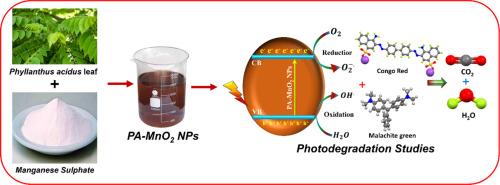Eco-friendly synthesis of manganese dioxide nanoparticles using phyllanthus acidus leaf: Assessing their potential photocatalytic activity against organic dyes
IF 6.3
2区 材料科学
Q2 CHEMISTRY, PHYSICAL
引用次数: 0
Abstract
In this research, an eco-friendly, cost-effective, and straightforward method was employed for the green synthesis of manganese dioxide nanoparticles (MnO2 NPs) using Phyllanthus acidus (PA) leaf extract as a natural reducing and stabilizing agent. Fourier-transform infrared (FTIR) spectroscopy confirmed the presence of functional groups from the plant extract, indicating their role in MnO2 NPs formation. UV–Vis spectroscopy exhibited an absorption peak at 345 nm, corresponding to the band gap of the synthesized PA-MnO2 NPs. X-ray diffraction (XRD) analysis validated the crystalline nature and phase of the obtained PA-MnO2 NPs. Brunauer-Emmett-Teller (BET) analysis further revealed a high specific surface area of 68.769 m2/g, which enhances the surface active sites available for catalytic reactions. Notably, the synthesized nanoparticles demonstrated remarkable catalytic activity in degrading organic dyes. Under visible light irradiation, MnO2 NPs facilitated the degradation of Congo Red (CR) with an efficiency of 84.42 % in 90 min. Additionally, they exhibited superior performance in degrading Malachite Green (MG), achieving an 87.43 % degradation efficiency within the same duration. These findings emphasize the potential of green-synthesized MnO2 NPs as an efficient and sustainable alternative for wastewater treatment and dye pollutant remediation.

用余叶酸梅叶环保合成二氧化锰纳米颗粒:评估其对有机染料的潜在光催化活性
在本研究中,采用一种环保、经济、简单的方法,以Phyllanthus acidus (PA)叶提取物为天然还原剂和稳定剂,绿色合成二氧化锰纳米颗粒(MnO2 NPs)。傅里叶变换红外光谱(FTIR)证实了植物提取物中官能团的存在,表明它们在MnO2 NPs形成中的作用。紫外可见光谱在345 nm处有一个吸收峰,与合成的PA-MnO2 NPs的带隙相对应。x射线衍射(XRD)分析证实了所得PA-MnO2 NPs的晶体性质和物相。brunauer - emmet - teller (BET)分析进一步揭示了高比表面积(68.769 m2/g),提高了催化反应的表面活性位点。值得注意的是,合成的纳米颗粒在降解有机染料方面表现出了显著的催化活性。在可见光照射下,MnO2 NPs对刚果红(CR)的降解效率在90 min内达到84.42%。此外,它们在降解孔雀石绿(MG)方面表现出优异的性能,在相同的持续时间内,降解效率达到87.43%。这些发现强调了绿色合成二氧化锰NPs作为废水处理和染料污染物修复的有效和可持续替代方案的潜力。
本文章由计算机程序翻译,如有差异,请以英文原文为准。
求助全文
约1分钟内获得全文
求助全文
来源期刊

Surfaces and Interfaces
Chemistry-General Chemistry
CiteScore
8.50
自引率
6.50%
发文量
753
审稿时长
35 days
期刊介绍:
The aim of the journal is to provide a respectful outlet for ''sound science'' papers in all research areas on surfaces and interfaces. We define sound science papers as papers that describe new and well-executed research, but that do not necessarily provide brand new insights or are merely a description of research results.
Surfaces and Interfaces publishes research papers in all fields of surface science which may not always find the right home on first submission to our Elsevier sister journals (Applied Surface, Surface and Coatings Technology, Thin Solid Films)
 求助内容:
求助内容: 应助结果提醒方式:
应助结果提醒方式:


